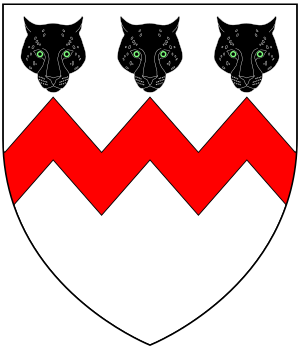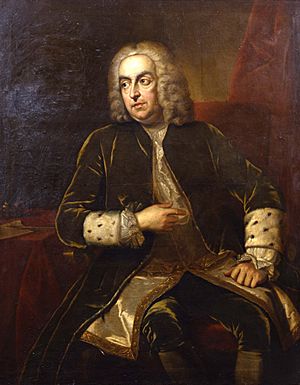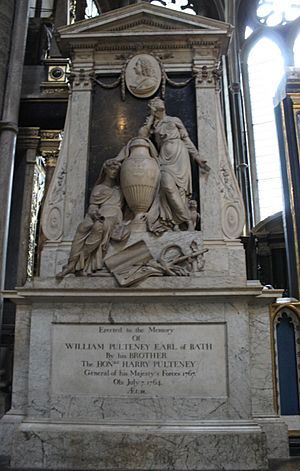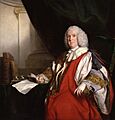William Pulteney, 1st Earl of Bath facts for kids
Quick facts for kids
The Earl of Bath
|
|
|---|---|

Earl of Bath, 1761, by Sir Joshua Reynolds
|
|
| Prime Minister of Great Britain | |
|
Disputed
|
|
| In office 10 February 1746 – 12 February 1746 |
|
| Monarch | George II |
| Preceded by | Henry Pelham |
| Succeeded by | Henry Pelham |
| Secretary at War | |
| In office 1714–1717 |
|
| Monarch | George I |
| Preceded by | Francis Gwyn |
| Succeeded by | James Craggs the Younger |
| Personal details | |
| Born |
William Pulteney
22 March 1684 Leicestershire, England |
| Died | 7 July 1764 (aged 80) |
| Resting place | Westminster Abbey |
| Political party | Whig |
| Spouse |
Anna Maria Gumley
(m. 1714; |
| Children | William Pulteney, Viscount Pulteney |
| Alma mater | Christ Church, Oxford |
| Occupation | Politician |
| Cabinet | Short-lived ministry |
William Pulteney, 1st Earl of Bath (born March 22, 1684 – died July 7, 1764) was an important English politician. He was a member of the Whig party. He served in the British House of Commons from 1707 until 1742. In 1742, King George II made him an Earl, which is a high rank in the British nobility.
Some people believe he was the Prime Minister of Great Britain for a very short time in 1746. This was part of a short-lived ministry (a government that didn't last long). However, most historians today do not consider him to have officially held the title of Prime Minister.
Contents
Early Life and Political Start
William Pulteney was born in March 1684 in Leicestershire, England. His father was also named William Pulteney. He went to Westminster School and then to Christ Church, Oxford university. He was very good at learning about classical history and languages. After university, he traveled around Europe.
In 1705, he became a Member of Parliament (MP) for the area of Hedon. He was helped by Henry Guy, who used to work for the government. Pulteney kept this seat in Parliament until 1734.
During the time of Queen Anne, William Pulteney was a strong supporter of the Whigs. He was involved in important political events, like the trial of Henry Sacheverell. When his friend Robert Walpole was sent to the Tower of London in 1712 by the opposing Tory party, Pulteney defended him in Parliament. He also visited Walpole in prison.
Working for the Government
From 1714 to 1717, Pulteney served as the Secretary of War under King George I. This meant he was in charge of the army. In 1715, he was part of a special committee that looked into the Treaty of Utrecht. In 1716, he became a member of the Privy Council, a group of important advisors to the King.
In 1717, when his friends Townshend and Walpole left their government jobs, Pulteney also resigned.
Later, after the South Sea Company financial crisis, Walpole became very powerful again. Walpole offered Pulteney a title as a peer, but Pulteney refused. In 1723, Pulteney accepted a job called Cofferer of the Household. This job paid well but didn't have much power. When he felt ignored, he started to disagree with Walpole's plans. In 1725, he was fired from this job.
Pulteney was also one of the people who helped start the Royal Academy of Music. This company created opera shows in London and hired famous composers like Handel.
Leading the Opposition
After being fired, Pulteney became a strong opponent of Robert Walpole's government. He formed a group called the Patriot Whigs. These were other Whigs who believed Walpole was using his power unfairly. Walpole tried to make peace with Pulteney in 1730 by offering him a high position and a peerage, but Pulteney still refused.
Pulteney didn't just speak out in Parliament. With Lord Bolingbroke, he started a newspaper called The Craftsman in 1726. In this paper, they constantly criticized Walpole for many years. Pulteney wrote many articles and pamphlets against Walpole.
Because of his writings, Pulteney was challenged to a duel by Lord Hervey. In 1731, he was removed from the list of Privy Councillors and lost his role as a justice of the peace in several counties.
Pulteney was a very skilled speaker in Parliament. In 1733, he strongly criticized the government's use of the sinking fund (money set aside to pay off national debt). He also spoke passionately against the Excise Bill in the same year, which caused a lot of public anger. Walpole managed to keep his government from falling apart.
From 1734, Pulteney was an MP for Middlesex. For several years, the opposition struggled to weaken Walpole's government. But in 1738, problems with Spain gave them a chance. Walpole wanted peace, but the public strongly wanted war. He eventually agreed to declare war on Spain in 1739.
In 1741, a new Parliament was elected. Walpole's government lost support and eventually collapsed.
Pulteney was then asked to help form a new government. He offered the top job of First Lord of the Treasury (like Prime Minister) to the Earl of Wilmington. Pulteney himself took a seat in the cabinet and accepted a peerage. He hoped to still have a lot of power, but this decision made him unpopular, and his influence quickly faded.
It is said that when Pulteney became the Earl of Bath and Walpole became the Earl of Orford, Walpole joked, "Here we are, my lord, the two most insignificant fellows in England." On July 14, 1742, Pulteney was given the titles Baron Pulteney, Viscount Pulteney, and Earl of Bath. He was also restored to the Privy Council. When the Earl of Wilmington died in 1743, Pulteney wanted to be First Lord of the Treasury, but Henry Pelham was given the job instead.
A Very Short Time as Prime Minister
On February 10, 1746, Henry Pelham's government resigned. King George II asked Bath to form a new government. Bath accepted and chose people for the main jobs. However, it quickly became clear that he did not have enough support to create a strong government. After only "48 hours, three quarters, seven minutes, and eleven seconds," he gave up. This forced the King to ask Pelham to return to his job.
Because the job of Prime Minister wasn't officially defined back then, historians debate whether Bath should be considered a Prime Minister for his two-day government.
Bath's failed attempt to form a government led to a lot of jokes and teasing. People made fun of how quickly his government ended.
Later Life and Legacy
After his short time in power, Bath mostly retired from active politics. He occasionally wrote pamphlets and gave speeches. Two bishops, Zachary Pearce and Thomas Newton, praised him during his retirement. In 1762, he served as treasurer for the Royal Salop Infirmary hospital in Shrewsbury.
William Pulteney was buried on July 17, 1764, in Westminster Abbey. His monument was created by the sculptor Joseph Wilton.
He married Anna Maria Gumley on December 27, 1714. She was the daughter of John Gumley. Anna Maria died in 1758. Their only son, William Pulteney, Viscount Pulteney, died unmarried in 1763.
Pulteney had a very large fortune. After his death, his money went to Frances, the wife of William Johnstone. Frances was the daughter of Pulteney's cousin, Daniel Pulteney, who was also an opponent of Walpole.
William Pulteney was not very fond of business matters. He missed his trusted friend John Merrill, who helped him with these things.
The town of Poultney, Vermont and the Poultney River in the United States were named after him.
Images for kids










